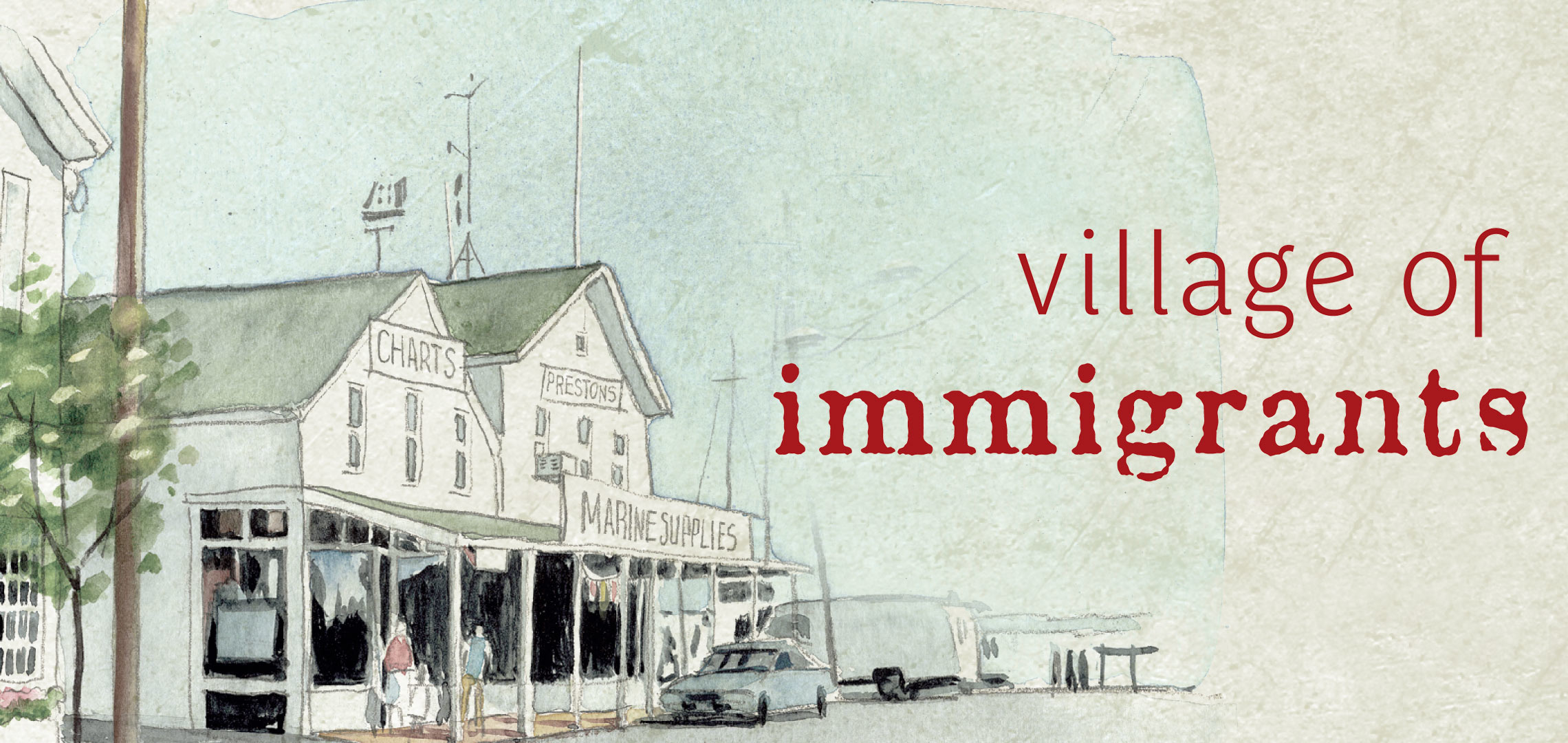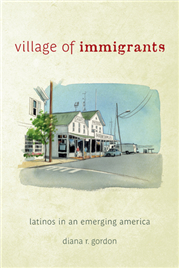It Takes an Immigrant to Raise a Village

Immigrants are said to be responsible for many things these days, but we will not dwell on the ugly immigrant blame game built up by some political candidates. Instead, let’s focus on what we know immigrants are responsible for: a reinvigorated economy in small-town America. Yes, that’s correct, despite what you might hear from political candidates who are allegedly good businesspeople. It’s what Diana Gordon discovered when the CUNY professor retired to the Long Island community of Greenport, population 2,200—about one-third of them Hispanic. Rip them from their communities and send them “back where they came from,” and the result will be economic ruin for the small American towns they call home. Gordon’s new book, Village of Immigrants: Latinos in an Emerging America, tells the story of how immigrants, even undocumented ones, have become a vital part of the American economy. We’ll let her tell more in the FTW interview below the news.
First, the News

Coming of Age in Frankfurt Nothing can prepare you for the Frankfurt Book Fair. The Buchmesse consists of millions of books in acres of stands over five days every October. In 1994, Foreword Reviews Publisher Victoria Sutherland first learned her Frankfurt lessons at the school of hard knocks. Read Victoria’s blog on lessons learned.

Indie Halloween: We’ve got ghosts, ghouls, and hauntings of every kind. You might just want to buy yourself a bowl of candy and read all night long. Get your costume, your candy, and your book—things are about to get scary. Don’t be afraid to sample these six indie Halloween treats.
Featured Reviews of the Week
Animals as Food: (Re)connecting Production, Processing, Consumption, and Impacts by Amy J. Fitzgerald. “An informed perspective and an objective voice contribute authority to this critique of animal farming and consumption.” Reviewed by Barry Silverstein.
The Game for Real by Richard Weiner, translated by Benjamin Paloff. “Czech Modernist writer Richard Weiner’s book requires the abandonment of expectations and the willingness to delve into the lines between reality and unreality.” Reviewed by Monica Carter.
The General and the Genius: Groves and Oppenheimer, the Unlikely Partnership That Built the Atom Bomb by James Kunetka. “The origin story of nuclear weaponry is brought to compelling light through the experiences of the two men who spearheaded the Manhattan Project.” Reviewed by Lee Polevoi.
Little Pretty Things by Lori Rader-Day. “A dank roadside motel plays a central role in this murder mystery involving teenage girls, competition, and festering secrets.” Reviewed by Lynn Evarts.
Simon’s Cat vs. the World by Simon Tofield. “Single-panel illustrations distill the essence of cat humor into beautifully rendered full-color pages.” Reviewed by Peter Dabbene.
Diana Gordon
It seems like this book is a direct counter to the anti-Latino and anti-immigrant rhetoric by Donald Trump and other presidential candidates. Immigrants contributing to the economic revival of small-town America: will this come as a surprise to many Americans?

Diana Gordon
Maybe it will surprise big-city residents. But the presence of a critical mass of newcomers is pretty noticeable in a small town or city. When they start opening businesses—restaurants and stores that bring new customers downtown and attract other businesses—their contributions are evident, at least locally. All over Iowa and in several small Minnesota towns the trend is dramatic. The mayor of West Liberty, Iowa (population 3762 in 2013, 25.6 percent foreign-born) has said, “[I]f we didn’t have the Hispanic community here we’d have a lot more empty businesses downtown.”
Perhaps the native-born will be surprised to discover how crucial immigrant workers are to particular sectors. Without the Hispanic workforce for rug companies in Georgia towns, the cost of American carpets would skyrocket. If undocumented farmworkers all walked off their jobs, supermarket shelves would be bare. (About half of US crop workers are undocumented.) And the poultry and meat processing industries are completely dependent on immigrant labor.
Let’s say, in a nightmare scenario, Donald Trump takes the Oath of Office in January 2017. The next day he orders the roundup and forced deportation of every single undocumented immigrant in this country. What would be the impact on these smaller communities?
Especially in towns like mine, with many amenities that appeal to visitors and are maintained by undocumented people, the effect would be immediate and disastrous. Who wants to spend a weekend in a seaside village where the restaurants have closed and the lawns of the B&Bs go unmowed? Widespread deportations would also affect the income of landlords and employers.
Furthermore, the declining school population that has beleaguered small towns all over the country is now reversing in some places as immigrants settle and form families. Deporting those families would have repercussions for educational personnel and for the businesses that service the schools. Most importantly, it would deplete a pool of future voters, workers, and volunteers.
The immigration story is an old one in America and, it seems, later arrivals are rarely welcomed with open arms. Will this wave of anti-immigrant sentiment pass?
Anti-immigrant Americans are a small but vocal minority. A June 2015 poll by the authoritative Pew Research Center found that only 27 percent of respondents thought undocumented immigrants should not be allowed to stay in the country. Of the remainder, more than half thought citizenship should be available to people who paid back taxes, learned English, and were crime-free. Unsurprisingly, Democrats (62 percent) were more likely than Republicans (27 percent) to believe that immigrants, whether undocumented or legally present, “strengthen the country through hard work and talents.”
If the past is any indication, attitudes will soften as the next generation matures. First-generation immigrant students are catching up or surpassing their native-born classmates academically, with some exceptions; the employment rate for males is higher than for the native-born. As immigrant children grow up, they are likely to be accepted as our grandparents were. Integration will probably be easier if the economy is healthy and Americans have confidence in it.
You worked with Rutgers University Press. How did that relationship come about?
I had written an academic book twenty-five years ago, which Rutgers published, and the editor remembered liking what I had written. Despite the budget cuts that most publishers, including Rutgers, have experienced, the press continues to provide outstanding support for its writers.
You also study, and write about, criminal justice. There’s a perception that immigrants bring higher crime. Does that perception have any relation to reality?
Not at all. Despite sensational reports of terrible crimes by individual immigrants, like this past summer’s murder of Kathryn Steinle in San Francisco, scholars have found, over and over, that communities with large proportions of immigrants have LOWER rates of crime and violence than those without. It’s in the second and third generation—thoroughly assimilated into American culture by now—that crime rates become similar to those of the population in general.
What are you reading now?
I am glued to Between the World and Me, Ta-Nehisi Coates’s long, anguished, powerful letter to his son. I keep turning back to reread paragraphs that embroider his central message about the history of American racial oppression that implicates us all, black and white and in between. For professional nourishment I am dipping in and out of New Destination Dreaming: Immigration, Race, and Legal Status in the Rural American South, by Helen B. Marrow. The book gives voice to immigrants even as its author, an assistant professor of sociology at Tufts, develops theory about how the South responds to them. Finally, I am loving Between You and Me: Confessions of a Comma Queen, a romp through the copyediting department of the New Yorker and the mind of its director.
